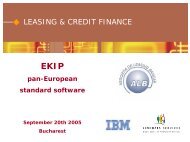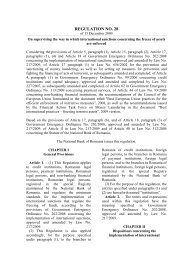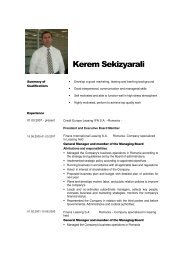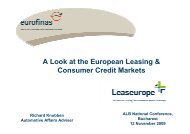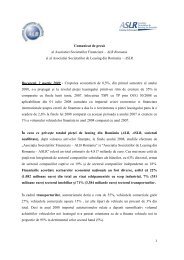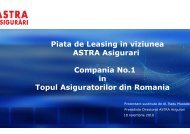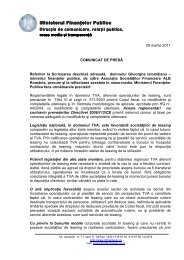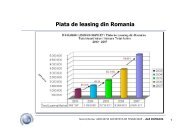Descarca catalogul - ALB
Descarca catalogul - ALB
Descarca catalogul - ALB
Create successful ePaper yourself
Turn your PDF publications into a flip-book with our unique Google optimized e-Paper software.
activitate. In timp ce dezvoltarea imobiliara<br />
cunoaste o evolutie negativa, contractele de<br />
sale & lease back dedicate zonei imobiliare<br />
au reprezentat o sursa alternativa pentru acei<br />
finantatori care au avut incredere si know-how<br />
in a supravietui in aceste vremuri dificile din<br />
punct de vedere macroeconomic. In consecinta,<br />
dinamica acestui sector ar trebui sa fie analizata<br />
mai mult caz cu caz si nu din perspectiva unei<br />
analize de nisa.<br />
In acest sens, cifrele de la H1 2012 comparate<br />
cu cele de la H1 2011, arata o crestere de<br />
la 1% la 57% in privinta ponderii finantarii<br />
hotelurilor, in timp ce ponderea finantarii<br />
cladirilor rezidentiale a crescut de la 5% la 6%.<br />
In contrast cu aceasta, s-au înregistrat scăderi<br />
in pondere ale finanţărilor cladirilor industriale<br />
de la 40% la 5%, ale terenurilor de la 31% la<br />
16%, a categoriei retail-outlet de la 5% la 1% şi<br />
a finanţării clădirilor de birouri clasa A, B şi C<br />
de la 18% la 15%.<br />
Datorita stimulentelor fiscale oferite de<br />
legislatia romaneasca in principal finantatorilor<br />
care sunt organizati ca agenti economici,<br />
clienţii persoane juridice au atras cea mai mare<br />
pondere (90%) din totalul finanţărilor, urmaţi<br />
de persoanele fizice (10%) şi de sectorul public<br />
(0%). Este interesant de mentionat faptul ca<br />
sectorul public nu are inca experienta utilizarii<br />
leasingului ca sursa de finantare, chiar daca<br />
legislatia parteneriatului public privat a fost<br />
armonizata cu respectiva Directiva europeana.<br />
Penetrarea leasingului in PIB-ul Romaniei<br />
indica o tendinta pozitiva in timpul perioadei<br />
premergatoare crizei si una negativa dupa<br />
criza financiara. Astfel, daca in 2008, primul<br />
an de declin pentru aceasta piata, indicele de<br />
penetrare este de 3,52%, in 2011 acelasi indice<br />
a atins nivelul de 0,99%. Cauza este una foarte<br />
transparenta si nu constituie un secret: criza<br />
financiara atat la nivel european, cat si la nivel<br />
local. Acest indice indica faptul ca piata de<br />
leasing din Romania este una emergenta care<br />
a supravietuit mediului macroeconomic foarte<br />
dificil la nivel european si acest fapt ne da<br />
field of activity. While the development of the<br />
real estate is on a negative evolution, the sale<br />
and lease back contracts dedicated to the real<br />
estate area, represented an alternative source<br />
of financing for those lessors that have proven<br />
confidence and know-how in surviving these<br />
difficult macroeconomic times. Consequently,<br />
the dynamics of this sector should be analysed<br />
much more on a case by case basis and not as a<br />
niche analysis.<br />
Thus, the figures of H12012 compared to H1<br />
2011, show an increasing from 1% to 57%<br />
related to the financing of the hotels in terms<br />
of weight, while the financing of the residential<br />
buildings weight increased from 5% to 6%.<br />
On the contrary, the financing of the industrial<br />
buildings decreased from 40% to 5%, land<br />
financing from 31% to 16%, retail-outlet from<br />
5% to 1% and the financing of the offices areas<br />
class A, B and C from 18% to 15%.<br />
Due to fiscal incentives offered by the Romanian<br />
legislation mainly to lessors that are organized<br />
as economic agents, the legal clients attracted<br />
the largest part (90%) of the total financings,<br />
followed by the individuals (10%). It is<br />
interesting to mention that the public sector<br />
has no experience yet in using leasing as a<br />
source of financing, even if the public private<br />
partnership legislation has been harmonized<br />
with the respective European Directive.<br />
The leasing penetration into Romanian GDP<br />
shows a positive trend during the pre-crisis<br />
period and a negative one after the financial<br />
crisis. Thus, if in 2008, the first year of decline<br />
for this market, the penetration index is at<br />
3.52% in 2011 this index has reached the level<br />
of 0.99%. The cause is very transparent and not<br />
a secret: the financial crisis both at the European<br />
and local level. This index indicates that the<br />
Romanian leasing market is an emerging<br />
one that has survived over the very difficult<br />
macroeconomic environment at the European<br />
level and that promises confidence in future<br />
25<br />
60184_file_interior_lucian_v9.indd 25<br />
11/5/2012 9:21:53 AM



